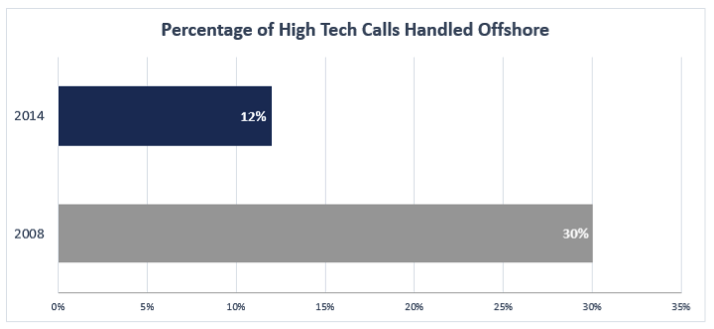
In the course of my business I speak to a few hundred contact center executives every year. One of the topics that seems to come up frequently is their offshore contact center outsourcing successes, failures and strategies.
Overall, outsourcing contacts to foreign countries is often perceived to be a necessary evil for a company wanting to be competitive in the global market. Consumers are demanding lower prices, shareholders are demanding more profits, and customer service often finds itself in the middle, getting the financial squeeze.
What I hear from business associates who offshore some or all of their contacts is that they feel the quality has improved over the past few years, but that prices are starting to rise. Also, consumers still have a negative opinion of offshored contact centers. If costs were comparable, many contact center executives have told me that they would instantly bring the jobs back.
The sense that offshoring customer contact is less than ideal comes through loud and clear in these interactions, but people are hesitant to act without more information. The costs of customer acquisition versus the loss of a percentage of customers due to offshoring contact centers is not currently measured in most organizations. Could this metric be the tipping point to bring the calls back onshore?
What Customers Really Think About Offshore Contact Centers
A Purdue University study found that some 65% of consumers would change their buying behavior if they learned that a company with which they were doing business used an offshore call center, even if they were satisfied with its customer service.
The study, conducted by Purdue’s Center for Customer-Driven Quality, showed that the “vast majority” of consumers believed their telephone contacts were handled by domestic call centers. The survey of 721 U.S. consumers had an error rate of plus or minus 4%.
According to the 2012 Contact Center Satisfaction Index (CFI Group 2010) customer frustration with offshore centers yields poor scores across the board. When rating their overall satisfaction, customers rated onshore centers significantly higher than those of their counterparts offshore. Eighty-one percent satisfaction for American-based contact centers versus 62% satisfaction for offshore-based contact centers.
Offshoring Has an Image Problem—Politics, Economics and Perception
American’s don’t like offshore contact centers and some have vowed to boycott any companies that require them to speak with an offshore agent.
The combination of economic insecurity and high unemployment often leads to insular thinking—a kind of circle-the-wagons mentality. As United Nations High Commissioner for Refugees and former Prime Minister of Portugal Antonio Guterres said, “In my experience as a politician, I’d say that when things go wrong in a country, there are two potential targets: one is the government, the other is the foreigners.”
The 2008-2009 Great Recession led to many Americans being out of work, while companies were outsourcing jobs offshore to save money. Consumers saw offshoring as fundamentally anti-American and expressed themselves through social media, mainstream media, and most importantly through their wallets. Consumers started moving away from companies that outsourced jobs out of America and the “Made in America” mantra expanded to include “Served by America.” Even several years into economic recovery, there remain many Americans who are unemployed or underemployed, and the “Buy American” idea is as strong as ever
Customer Effort Matters, Even When Things Turn Out Well
One reason for dissatisfaction is mechanical—customers simply report having a difficult time understanding offshore agents, a communication problem that leads to ineffective and inefficient interactions and process. Even when it works out—in interactions in which the outcome is the exact same with an onshore versus an offshore agent—the perception of service is consistently lower for offshore agents. At a basic level, interacting with an unfamiliar dialect is more challenging to people and requires them to work a little harder to both take in information and make themselves understood, particularly among older people or people with reduced hearing or lack of exposure to new dialects. On the face of it, this is just another way that organizations set themselves up for high or low Customer Effort Scores.
Customer Effort Scores or CES developed as a customer service concept from research published in the “Harvard Business Review” in 2010, and they’re based on the idea that when customers have to expend more effort than they expect, they leave. In regards to offshoring customer contact, it follows that even well-managed obstacles—centers that employ very highly-skilled English speakers—are still obstacles and increase the amount of effort a customer must expend to complete a task.
Offshored Call Percentage on the Decline
Consumer perception of service has a direct effect on the brand strength. Because of this, many American organizations are seeing value in bringing contact center jobs back to America. In fact, the percentage of calls being outsourced to foreign countries has decreased consistently over the past few years across almost every industry. Thirty percent of high-tech contacts offshore in 2008 versus only 12% today.
So what to do? If customers are important to you (which I believe they are), can you afford to lose customers to real communication or perceived political problems?


